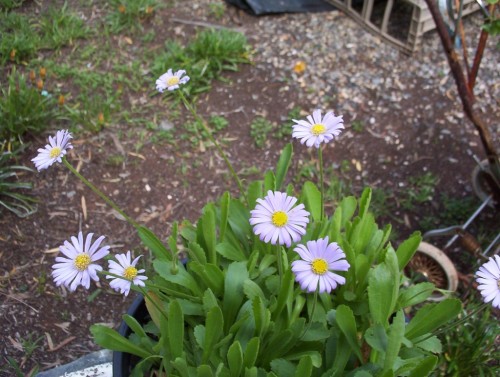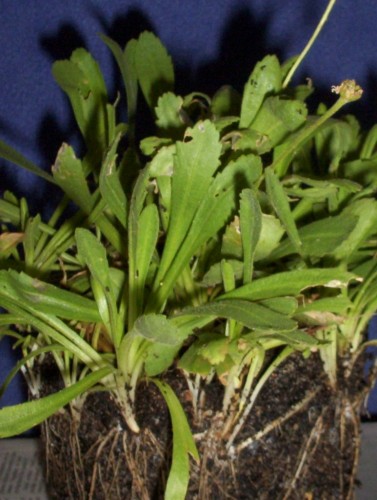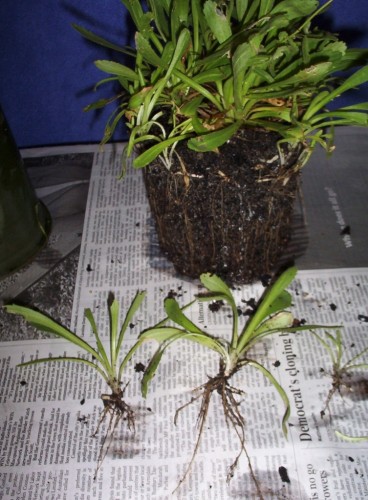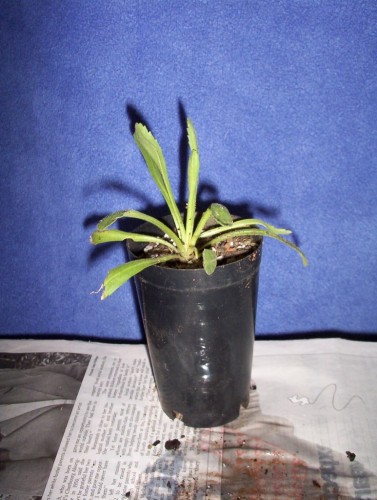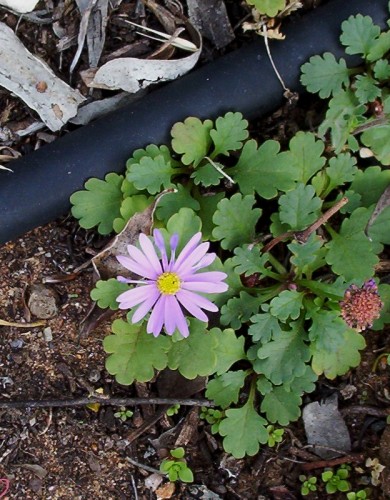Brachyscome tenuiscapa var pubescens
This little plant is a daisy 10-20cm high and 20-40cm wide and would make a great cottage garden plant in a shaded position during summer. It would also be good in a rockery or pot which is where I have it. I haven’t been confident about trying it in the ground. Now that I know how easily it is propagated I can try it in the ground. It is a little perennial in that it dies down during the heat of summer to reappear in autumn. It spreads rapidly by suckering and is the plant featured in the previous post. It needs root protection which can be achieved with gravel or stones or an organic mulch.
The flowers are mauve, 2-3cm across, and held above the leaves. It flowers in spring and autumn. It does best in cooler climates but is worth trying where a good mulch can be applied. It is frost tolerant to -5C. Snails and slugs love it, so precautions need to be taken. If the plant becomes tatty, cut the leaves off above the crown and fertilise and water.
Make New Plants…By Dividing What You Have
Sorting plants today, I came across some native daisies and violets and grasses which were very tight in their pots. There were multiple plants jammed in as the original plant had multiplied over the past year. The way to deal with them is to divide the pot full and repot the smaller bits or plant straight into the garden. The same applies for a clump that has got out of hand in the garden. A spade can be used to dig up a section which can be divided into smaller portions, some to replant and others to pot on to give away to appreciative folk or placed on a fund raising stall. Let the plants settle and grow on for a few weeks before doing this. Now would be a good time to divide and repot if plants are intended as Christmas gifts. The plant in the photos is a daisy Brachyscome tenuiscapa variety pubescens.
The process is simple. Gather a serrated edged knife (like an old bread knife), secateurs, pots and potting mix and something with which to label the plant. Up end the pot and remove the whole clump. Examine the root ball to see where the divisions might be made.
It is often easier to shake the potting mix from the roots so that individual small plants can be seen. Use knife or secateurs to cut between each plant, ensuring that some roots remain on each piece. If there are no roots on some good pieces place them in some propagating mix and treat as a cutting. The other pieces can be repotted or planted out.
Eremophilas To Rescue
Eremophila purpurascens is one of the plants we need to rescue from the bulldozer. It is on the edge of the planting but will probably be damaged. We won’t be able to move it so as much cutting material as possible has been taken. After such a dry winter this is sparse so we put the hose on it trickling for half an hour to increase the material in this next week or so.
This is a pretty plant one and a half metres high and wide, flowering from August to October. Here it has some flowers at other times of the year too. It is a Western Australian species from an area of granite but it copes well with the high pH of the soil here. It is actually growing in fairly deep mallee sand which provides good drainage. It is also frost and drought hardy.
Rescuing A Little Daisy
I met one of the Australian Plant Society members at the garden that is going to be bulldozed. We had to make an educated guess as to where the damage is going to be done. There are a lot of plants involved in the area.
One of the first and easiest tasks was to dig up a little daisy, Brachsycome formosa.
This is quite a small plant which multiplies by suckering. I have probably not given it the correct name. The Australian Daisy Study Group book on Brachyscomes calls this plant Brachyscome affinity formosa, meaning it is like it (known as Pilliga Daisy) but not quite. This one has a pretty mauve flower whereas Pilliga Daisy is cerise pink. It sends up new shoots away from the original plant. It is remarkably hardy. It survives by dying back during the heat of the summer, reappearing after autumn rains. We found dozens of little plants, some of which we potted with a view to relocating in the garden and others to pot at home as insurance. Considering the low rainfall here, this little plant is worth trying.
.
Make Cuttings To Save Plants
Our local group of the Austarlian Plant Society planted many native plants in a scrub area attached to a retirement village in 1986. This was part of the South Australian Jubilee 150 Celebrations. Many of the plants are rare or endangered. We heard today that a part of the garden will soon be bulldozed to make way for more development in the village. It is a shame this will happen. The garden is part of the amenity available to residents.
As a result of this development we are going to chop the plants in order to take as many cuttings as possible so the plants will not be wasted. The small plants we will attempt to relocate even if we have to pot them first and treat them as large ‘cuttings’.
This garden has been the source for many plants I have raised from cuttings. Many of the plants are only available at Autumn and Spring Plant Sales held by the Australian Plant Society because I have been fortunate in being able to strike cuttings from them.
